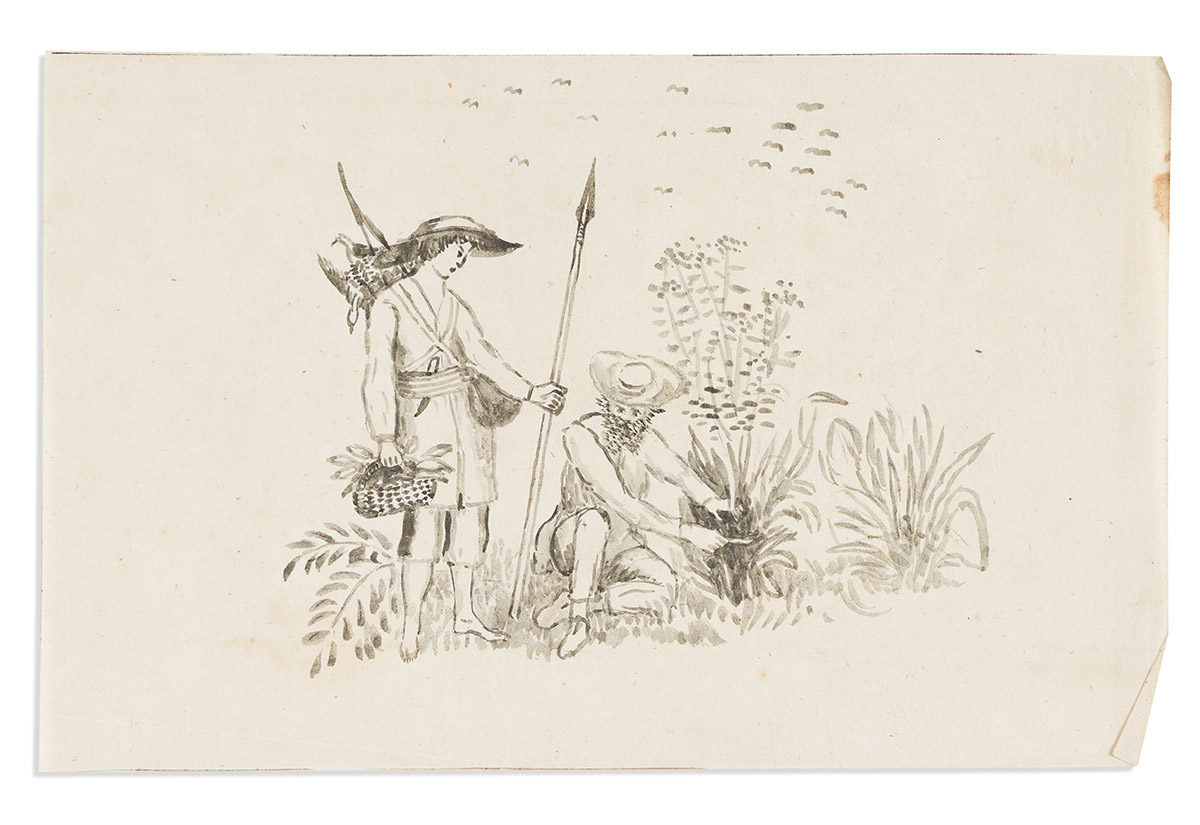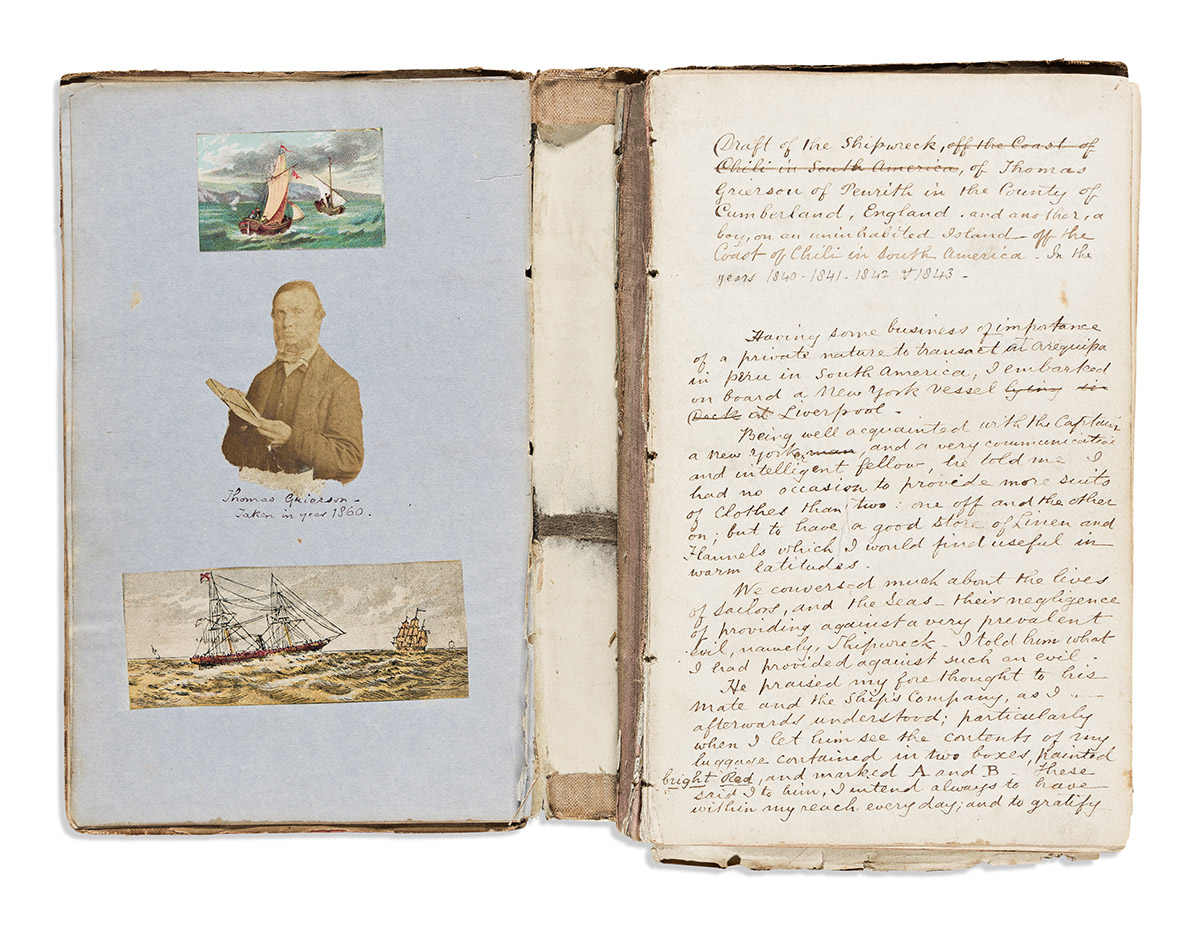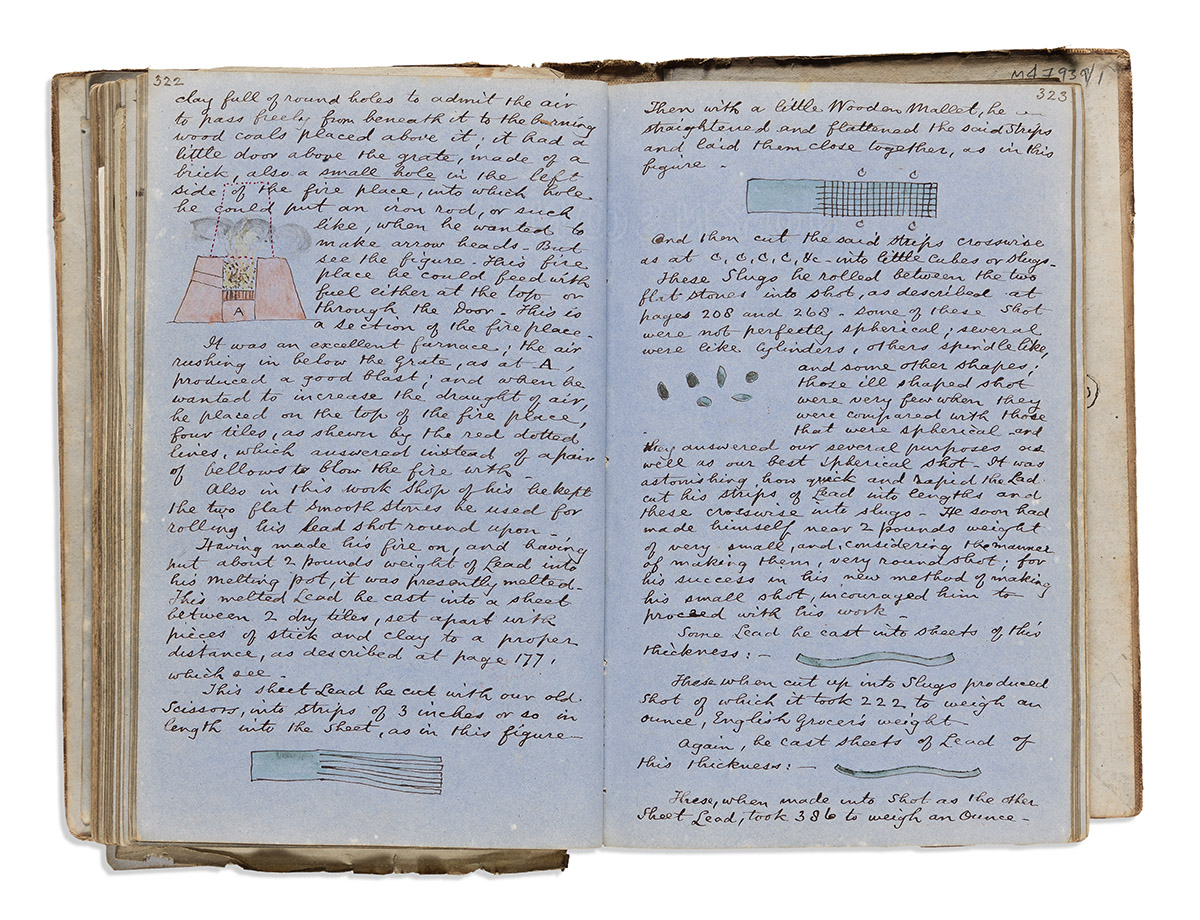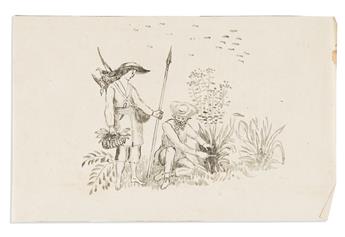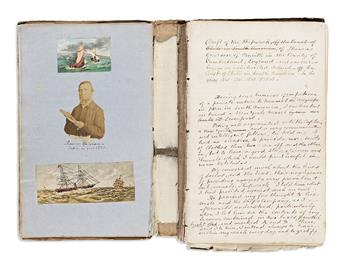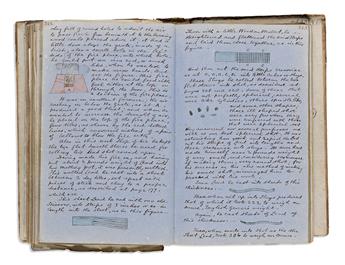Sale 2648 - Lot 190
Price Realized: $ 1,900
Price Realized: $ 2,375
?Final Price Realized includes Buyer’s Premium added to Hammer Price
Estimate: $ 3,000 - $ 5,000
Grierson, Thomas (1816-1894)
Three Diaries Including an Account of a Shipwreck.
Penrith, England, circa 1875.
Two quarto volumes covering the years 1874 and 1875 each containing hundreds of hand-written pages, a very detailed daily diary with numerous examples of inserted ephemera, correspondence, original sketches, and family photographs, each bound in contemporary half leather and marbled paper boards, sewing perished, each 9 x 7 in.; [and] one octavo volume containing the handwritten narrative of a shipwreck and life on a deserted island between 1840 and 1843, illustrated with sketches and small watercolors, with additional drawings of scenes on the island inserted; the text begins with the sea journey, with an account of a storm and wreck off the coast of Chile, but the main body of the densely-inscribed 450+ pages is taken up with detailed descriptions of our author and his companion's great success in building, inventing, and fending for themselves; half leather, and paper-covered boards, sewing perished, 8 x 5 in.
Grierson of Penrith, Cumberland, according to census records from the 1860s, was an accountant and solicitor's general clerk. He married Elizabeth Taylor in 1855, and the two had five children together. Although it is possible that Grierson went to sea and spent four years stranded on a desert island, no evidence of his voyage or wreck could be found by this researcher. His narrative also carries a certain vagueness that answers more to fiction than fact. Even so, the tale was not transcribed during the adventure, but years later. If Grierson did all he claims to have done and made, he must have landed on a most hospitable isle, on which he was able to procure any number of useful raw materials. In addition, he set out on his ill-fated sea journey almost presciently well-equipped. Grierson boarded in possession of two floating wooden chests filled with every survival tool and supply one could want, whose construction and contents he describes in great detail. In addition to making bows and arrows, buttons, canoes, glue, grindstones, huts, hats, hooks, ink, paper, soap, and umbrellas, among other things, Grierson is also able to find wild tobacco, tapioca, clay & glaze materials, a source of fresh water, plenty of wild game, and no indigenous neighbors. In any case, Grierson clearly had extraordinarily good knowledge of many disciplines, crafts, and skills, not to mention his ability to tell a good story and illustrate it to boot.
In his diaries, Grierson shows his astute observations of daily life and events in the vicinity of Penrith, along with news of the family told through photographs, notes, printed labels, broadsides, and news clippings. In addition to reporting the content of his received correspondence, Grierson also includes the actual letters, tipping them onto stubs at the appropriate places in the diaries. When he takes the train, he tells the exact minute (11:42 am), station (Burton & Holme), fee (3 shillings, 14 1/2 pence each), stipulating the class of the tickets (3rd), the luggage carried (small tin japanned round box, paper band box, two umbrellas), and whether it was heavy or light (luggage light --womens wear--). At a funeral, he notes the depth of the grave, "the joiner measured the depth for me before the grave was filled up after the company had gone." Regardless of the actual life history of Grierson, from what he's left us, we can see that he was an observant, kind, and industrious man possessed of a passion for making and recording the results of his experiments and efforts.
Three Diaries Including an Account of a Shipwreck.
Penrith, England, circa 1875.
Two quarto volumes covering the years 1874 and 1875 each containing hundreds of hand-written pages, a very detailed daily diary with numerous examples of inserted ephemera, correspondence, original sketches, and family photographs, each bound in contemporary half leather and marbled paper boards, sewing perished, each 9 x 7 in.; [and] one octavo volume containing the handwritten narrative of a shipwreck and life on a deserted island between 1840 and 1843, illustrated with sketches and small watercolors, with additional drawings of scenes on the island inserted; the text begins with the sea journey, with an account of a storm and wreck off the coast of Chile, but the main body of the densely-inscribed 450+ pages is taken up with detailed descriptions of our author and his companion's great success in building, inventing, and fending for themselves; half leather, and paper-covered boards, sewing perished, 8 x 5 in.
Grierson of Penrith, Cumberland, according to census records from the 1860s, was an accountant and solicitor's general clerk. He married Elizabeth Taylor in 1855, and the two had five children together. Although it is possible that Grierson went to sea and spent four years stranded on a desert island, no evidence of his voyage or wreck could be found by this researcher. His narrative also carries a certain vagueness that answers more to fiction than fact. Even so, the tale was not transcribed during the adventure, but years later. If Grierson did all he claims to have done and made, he must have landed on a most hospitable isle, on which he was able to procure any number of useful raw materials. In addition, he set out on his ill-fated sea journey almost presciently well-equipped. Grierson boarded in possession of two floating wooden chests filled with every survival tool and supply one could want, whose construction and contents he describes in great detail. In addition to making bows and arrows, buttons, canoes, glue, grindstones, huts, hats, hooks, ink, paper, soap, and umbrellas, among other things, Grierson is also able to find wild tobacco, tapioca, clay & glaze materials, a source of fresh water, plenty of wild game, and no indigenous neighbors. In any case, Grierson clearly had extraordinarily good knowledge of many disciplines, crafts, and skills, not to mention his ability to tell a good story and illustrate it to boot.
In his diaries, Grierson shows his astute observations of daily life and events in the vicinity of Penrith, along with news of the family told through photographs, notes, printed labels, broadsides, and news clippings. In addition to reporting the content of his received correspondence, Grierson also includes the actual letters, tipping them onto stubs at the appropriate places in the diaries. When he takes the train, he tells the exact minute (11:42 am), station (Burton & Holme), fee (3 shillings, 14 1/2 pence each), stipulating the class of the tickets (3rd), the luggage carried (small tin japanned round box, paper band box, two umbrellas), and whether it was heavy or light (luggage light --womens wear--). At a funeral, he notes the depth of the grave, "the joiner measured the depth for me before the grave was filled up after the company had gone." Regardless of the actual life history of Grierson, from what he's left us, we can see that he was an observant, kind, and industrious man possessed of a passion for making and recording the results of his experiments and efforts.
Exhibition Hours
Exhibition Hours
Aliquam vulputate ornare congue. Vestibulum maximus, libero in placerat faucibus, risus nisl molestie massa, ut maximus metus lectus vel lorem.



